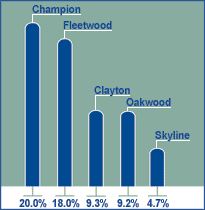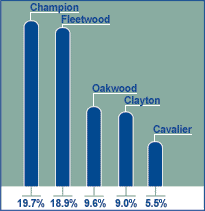

|
Manufactured |
 |
|
| Manufactured Housing Industry Sales Declines Continued | ||
 |
The manufactured housing industry continues to struggle with excess
inventory. Both capacity growth (retail, manufacturing and lending)
that outpaced the market and repossessions that followed the industry’s
previously aggressive financing practices contributed to the problem.
In addition, recent restrictive retail financing has made it difficult
for potential customers to purchase homes. Retail sales slipped to 257,381
homes in calendar 2000 from 315,662 in calendar 1999, a drop of 18.5
percent; this decline follows a drop of 6.5 percent from 1998 to 1999.
As a result, retail revenues were at their lowest level since 1991.
In the first calendar quarter of 2001, the industry slippage continued; retail sales dropped 38.8 percent from the same period in the prior year. This sustained contraction has resulted in the closure of more than 90 manufactured housing facilities and an estimated 2,500 retailers during the past 24 months. |
|
| Fleetwood “Rightsizing” Strategies Reduced Costs and Excess Inventories | |
|
Through rigorous cost cutting, our manufactured housing arm remained
profitable in fiscal 2001, despite the difficult environment. The group
recorded operating income (before intercompany profit/loss elimination)
of $27.4 million on gross revenues of $981.4 million compared with $83.8
million on $1.52 billion in the prior year. While market share continues to be an important measure of our success,
during this downturn most industry players have offered steep wholesale
discounts, while we have chosen to focus instead on lowering retailer
inventory levels at a profitable pace. We believe this financially sound
strategy has succeeded with only a slight short-term erosion in our
retail and wholesale market share. Consistent with our rightsizing initiative, we idled 10 manufacturing
facilities during the fiscal year, thus aligning our capacity with current
market demand. We expect this adjusted capacity will be adequate for
the anticipated market rebound. The cost of capacity alignment was $12.2
million, but will yield projected annual savings of $10.4 million. Inventories at independent retailers and Company-owned sales centers have been reduced by an average of 34 percent during the fiscal year. The goal of this adjustment was to reduce operating costs for our independent retailers and for Fleetwood. |
Market Share Leaders manufactured housing wholesale 2000  Source: Manufactured Home Merchandiser, June 2001 Year-End 2000 Statistics |
| “I'm making things easier.” | |
|
It’s exciting to envision an organizational change, and then
be appointed to direct the effort. Three years ago, Wes Chancey saw the possibilities for improved Having worked in both the retail and manufacturing sides of our industry
for 28 years — 13 of those with Fleetwood — Wes’ experience
convinced him that a single sales organization would make it easier
for our independent retailers to do business with us, eliminate internal
competition and create accountability throughout the organization. The
only concern — that salespeople might lose touch with the plant
and product — led to the incorporation of effective, consistent
communication tools. “We’ve cut costs with the new structure,” Wes says, “but that wasn’t the driver. We wanted to make life simpler for our customers.”
(return
to shareholder message section) |
 Wes Chancey Vice President Sales/Marketing/Product Design Housing Group |
| Retail, Marketing and Consolidation Moves Made to Increase Sales and Efficiency | |
|
Assisting our retailers to achieve continued success remains a very
high priority. We currently sell more than 77 percent of our homes through
independent retailers, and we have found that, on average, exclusive
Fleetwood retailers sell about twice as many homes on a per-lot basis
as do non-exclusive retailers. Thus, we continue our efforts to expand
our exclusive retailer base through the attractive Fleetwood Homes Pinnacle
Retailer Program, which began in January 2000. The Pinnacle Program
offers many advantages to its members and, since its inception, has
grown to an impressive 443 participating retailers. Other non-Pinnacle,
exclusive retailers number 336. We believe that the combination of marketing
support and training programs that we provide to Pinnacle retailers
will allow us to continue to build our exclusive network. Approximately
60 percent of our retailers are exclusive and we believe that this is
a significant reason why, according to third-party research, Fleetwood
is the most recognized brand in the industry. We have also focused on new marketing channels and product innovation during this downturn. These efforts to seek access to new customers have generated exclusive agreements with SAM’S CLUB and AARP for the marketing of manufactured housing, as well as contracts with GE Modular Space to produce relocatable office structures for construction sites and other uses. |
Market Share Leaders manufactured housing retail 2000  Source: Statistical Surveys, Inc. Year-End 2000 Statistics |
|
Organizational changes during the year included the consolidation of our three Housing regional groups into two. Wes Chancey, previously regional vice president of our Central Region, has been named our Housing Group’s vice president of sales, marketing and product design. (Read more on Wes and this new position.) Jim Holmes and Charley Lott continue as regional vice presidents of the expanded Western and Eastern regions, respectively. Also, Ron Brewer has been named vice president of manufacturing and engineering (Ron is featured here) and Gary Johnson has added international business development to his responsibilities as vice president of materials. Finally, Bill Byrnes continues to lead our service reorganization in the transition from plant-based service centers to regional service centers. (Read more about the new centers.) |
|
| Outlook for Manufactured Housing Is Positive | |
|
During the first quarter of fiscal 2002, we have experienced an improvement
in our backlogs and have increased production rates accordingly. We expect that continuing population growth — especially within
demographic groups that traditionally have been manufactured housing
customers — will support our industry for many years to come. Current
industry woes are not being caused by a lack of demand among retail
customers, but rather a combination of oversupply and restrictive financing.
As these problems are corrected — and we are confident that they
will be — we expect industry sales to return to more normal levels. Before the current downturn, manufactured housing accounted for more than 25 percent of all new single-family homes sold in the last decade — an impressive number since more than two-thirds of American households own their own homes. Given that manufactured homes offer quality construction at less than half the cost per square foot of a site-built home, we expect to continue to provide much-needed affordable housing, which will enable us to aggressively pursue our mission statement: “We fulfill the dream of home ownership by providing the best housing value and customer satisfaction.” |
|
| “I'm making smart moves.” | |
|
|
You might expect a person to settle for the status quo after working
for a company for 21 years. Donna Jamieson won’t. “I envision
Fleetwood as a world-class service organization,” Donna says. “I
not only want us to have the best service in our industry, but
in any industry.” And so, the Service Group set out to make a difference. Realizing that
our manufactured housing customers were getting inconsistent service,
Donna drafted standards and systems for the 29 plant-based service departments.
Bill Byrnes, V.P. of Service, noted that consolidation into three regional
service centers would increase efficiency further. (In one area, for
example, Fleetwood had five service departments within a 50-mile radius.)
Today, these strategically located centers are up and running. “Our
customers get a live voice from the beginning,” Donna says, “and
our people are much more efficient at resolving customers’ problems.”
Another problem solved: contractors were picking up parts for each
individual job from our service departments before driving to the warrantied
home — round trips that could total as much as 300 miles. Now,
parts are delivered to them in the field, allowing more time for repairs
and saving considerably on travel costs. But Fleetwood’s service vision is not yet fully realized. Now Donna and her team are working to expand the service centers into profit centers by offering home installation, non-warranty repairs and part sales — more ways to ensure customer satisfaction and differentiate Fleetwood from the competition. (return to
shareholder message section) |
| Retail and Manufacturing Operations Joined for Strategic Growth |
|
Our Housing retail division was recently merged with our Housing manufacturing
group, resulting in a more cohesive and synergistic housing effort.
Jack Darnall was appointed president of Fleetwood Retail Corp. (FRC)
near the end of the fiscal year, reporting to Senior Vice President
Chuck Wilkinson, who now leads the unified group. Already we are seeing
many positive initiatives from this reorganization, including a significant
reduction in retail inventory, which is an important step in controlling
costs. FRC was established in 1998 in response to market pressures, not the
least of which was the loss of important parts of our retailer network
when competitors began purchasing our strongest independent retailers.
Other factors influencing this move to retail included the opportunity
to significantly improve As previously noted, the market was booming in 1998 when we entered
the retail arena. More recently, market deterioration has required a
difficult and ongoing effort to rightsize our Company-owned retail store
network. Continued market shrinkage throughout fiscal 2001 dictated
deep inventory reductions and other cost-cutting actions, including
significant consolidation of our retail network during the latter part
of the year, when we sold or closed 73 sales centers. These rightsizing actions resulted in significant restructuring charges
that, combined with the difficult During this market correction, FRC is diligently focusing on Company initiatives that will enable us to achieve targeted results. One example is the creation of Home Sentry Insurance Agency, Inc., an affiliate company of FRC, that allows us to provide insurance products at the point of sale, thus offering convenience for our customers and providing us with an additional revenue stream. This initiative will assure FRC home center customers access to competitive, first-rate insurance products. We have also been able to refine and strengthen operational systems and controls that will be the foundation for future growth in a stronger market environment. |
| “I'm simplifying the process.” | ||
|
Ron Brewer brings an important ingredient to a number of initiatives in our Housing Group: focus. A software program to produce architectural drawings, for example,
was stalled because of too many requirements. Ron asked the simple question:
what does a production line associate really need to build a house accurately?
The software was revised — almost entirely in-house in six months’
time — and the results were dramatic. “We now produce accurate,
complete plans in just a few days — a task that might have taken
up to two months previously,” Ron says. A bill of materials is
being included in the system to assist the purchasing group, and the
software will generate accurate, consistent labor hours for pricing
and incentive purposes. In addition, the system will produce a “virtual
walk-through” CD for each building plan, enhancing our sales efforts. Ron is working on standardizing construction materials and methods,
as well. For example, Fleetwood’s 29 plants had been ordering hundreds
of different window sizes, not to mention types and brands. Now, they
work from a cost-efficient list of streamlined options. Ron is also a driving force behind our plants’ safety improvement, helping our Housing Group to set records recently for the fewest number of accidents. Lost time and workers’ compensation are also at an all-time low. So how has Ron managed to streamline production and purchasing, lower costs and reduce accidents? Simply, focus. (return to
shareholder message section) |
|
|
| <<Previous (Recreational Vehicles) |
Return to Top | Next>> (Directors and Officers) |